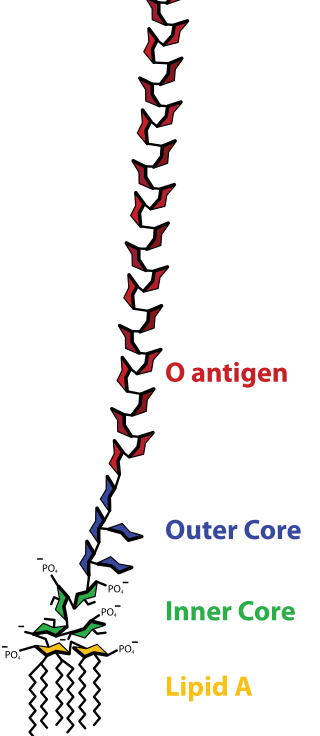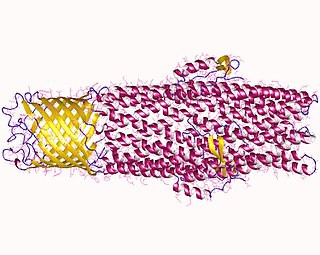
An antibiotic is a type of antimicrobial substance active against bacteria. It is the most important type of antibacterial agent for fighting bacterial infections, and antibiotic medications are widely used in the treatment and prevention of such infections. They may either kill or inhibit the growth of bacteria. A limited number of antibiotics also possess antiprotozoal activity. Antibiotics are not effective against viruses such as the ones which cause the common cold or influenza; drugs which inhibit growth of viruses are termed antiviral drugs or antivirals rather than antibiotics. They are also not effective against fungi; drugs which inhibit growth of fungi are called antifungal drugs.

A bacteriophage, also known informally as a phage, is a virus that infects and replicates within bacteria and archaea. The term was derived from "bacteria" and the Greek φαγεῖν, meaning "to devour". Bacteriophages are composed of proteins that encapsulate a DNA or RNA genome, and may have structures that are either simple or elaborate. Their genomes may encode as few as four genes and as many as hundreds of genes. Phages replicate within the bacterium following the injection of their genome into its cytoplasm.

Gram-negative bacteria are bacteria that do not retain the crystal violet stain used in the Gram staining method of bacterial differentiation. Their defining characteristic is their cell envelopes, which consists of a thin peptidoglycan cell wall sandwiched between an inner (cytoplasmic) membrane and an outer membrane. These bacteria are found in all environments that support life on Earth.

Lipopolysaccharides (LPS) are large molecules consisting of a lipid and a polysaccharide that are bacterial toxins. They are composed of an O-antigen, an outer core, and an inner core all joined by covalent bonds, and are found in the bacterial capsule, the outermost membrane of cell envelope of Gram-negative bacteria, such as E. coli and Salmonella. Today, the term endotoxin is often used synonymously with LPS, although there are a few endotoxins that are not related to LPS, such as the so-called delta endotoxin proteins produced by Bacillus thuringiensis.

Acinetobacter is a genus of Gram-negative bacteria belonging to the wider class of Gammaproteobacteria. Acinetobacter species are oxidase-negative, exhibit twitching motility, and occur in pairs under magnification.

Colistin, also known as polymyxin E, is an antibiotic medication used as a last-resort treatment for multidrug-resistant Gram-negative infections including pneumonia. These may involve bacteria such as Pseudomonas aeruginosa, Klebsiella pneumoniae, or Acinetobacter. It comes in two forms: colistimethate sodium can be injected into a vein, injected into a muscle, or inhaled, and colistin sulfate is mainly applied to the skin or taken by mouth. Colistimethate sodium is a prodrug; it is produced by the reaction of colistin with formaldehyde and sodium bisulfite, which leads to the addition of a sulfomethyl group to the primary amines of colistin. Colistimethate sodium is less toxic than colistin when administered parenterally. In aqueous solutions it undergoes hydrolysis to form a complex mixture of partially sulfomethylated derivatives, as well as colistin. Resistance to colistin began to appear as of 2015.
Multiple drug resistance (MDR), multidrug resistance or multiresistance is antimicrobial resistance shown by a species of microorganism to at least one antimicrobial drug in three or more antimicrobial categories. Antimicrobial categories are classifications of antimicrobial agents based on their mode of action and specific to target organisms. The MDR types most threatening to public health are MDR bacteria that resist multiple antibiotics; other types include MDR viruses, parasites.

The bacterial outer membrane is found in gram-negative bacteria. Gram-negative bacteria form two lipid bilayers in their cell envelopes - an inner membrane (IM) that encapsulates the cytoplasm, and an outer membrane (OM) that encapsulates the periplasm.

In microbiology, efflux is the moving of a variety of different compounds out of cells, such as antibiotics, heavy metals, organic pollutants, plant-produced compounds, quorum sensing signals, bacterial metabolites and neurotransmitters. All microorganisms, with a few exceptions, have highly conserved DNA sequences in their genome that encode efflux pumps. Efflux pumps actively move substances out of a microorganism, in a process known as active efflux, which is a vital part of xenobiotic metabolism. This active efflux mechanism is responsible for various types of resistance to bacterial pathogens within bacterial species - the most concerning being antibiotic resistance because microorganisms can have adapted efflux pumps to divert toxins out of the cytoplasm and into extracellular media.

Acinetobacter baumannii is a typically short, almost round, rod-shaped (coccobacillus) Gram-negative bacterium. It is named after the bacteriologist Paul Baumann. It can be an opportunistic pathogen in humans, affecting people with compromised immune systems, and is becoming increasingly important as a hospital-derived (nosocomial) infection. While other species of the genus Acinetobacter are often found in soil samples, it is almost exclusively isolated from hospital environments. Although occasionally it has been found in environmental soil and water samples, its natural habitat is still not known.

Growth/differentiation factor 15 is a protein that in humans is encoded by the GDF15 gene. GDF15 was first identified as Macrophage inhibitory cytokine-1 or MIC-1.

Multidrug-resistant bacteria are bacteria that are resistant to three or more classes of antimicrobial drugs. MDR bacteria have seen an increase in prevalence in recent years and pose serious risks to public health. MDR bacteria can be broken into 3 main categories: Gram-positive, Gram-negative, and other (acid-stain). These bacteria employ various adaptations to avoid or mitigate the damage done by antimicrobials. With increased access to modern medicine there has been a sharp increase in the amount of antibiotics consumed. Given the abundant use of antibiotics there has been a considerable increase in the evolution of antimicrobial resistance factors, now outpacing the development of new antibiotics.
RmYN02 is a bat-derived strain of Severe acute respiratory syndrome–related coronavirus. It was discovered in bat droppings collected between May and October 2019 from sites in Mengla County, Yunnan Province, China. It is the second-closest known relative of SARS-CoV-2, the virus strain that causes COVID-19, sharing 93.3% nucleotide identity at the scale of the complete virus genome. RmYN02 contains an insertion at the S1/S2 cleavage site in the spike protein, similar to SARS-CoV-2, suggesting that such insertion events can occur naturally.
RacCS203 is a bat-derived strain of severe acute respiratory syndrome–related coronavirus collected in acuminate horseshoe bats from sites in Thailand and sequenced by Lin-Fa Wang's team. It has 91.5% sequence similarity to SARS-CoV-2 and is most related to the RmYN02 strain. Its spike protein is closely related to RmYN02's spike, both highly divergent from SARS-CoV-2's spike.
Bat coronavirus RpYN06 is a SARS-like betacoronavirus that infects the horseshoe bat Rhinolophus pusillus. It is a close relative of SARS-CoV-2 with a 94.48% sequence identity.
The following scientific events occurred or were scheduled to occur in 2023.

Sulbactam/durlobactam, sold under the brand name Xacduro, is a co-packaged medication used for the treatment of bacterial pneumonia caused by Acinetobacter baumannii-calcoaceticus complex. It contains sulbactam, a beta-lactam antibacterial and beta-lactamase inhibitor; and durlobactam, a beta-lactamase inhibitor.

Abaucin is a compound which has been reported to show useful activity as a narrow-spectrum antibiotic. There is evidence that it is effective against Acinetobacter baumannii, which is one of the three superbugs identified by the World Health Organization as a "critical threat" to humanity. Notably, abaucin was developed with assistance from artificial intelligence by a team led by the MIT Jameel Clinic's faculty lead for life sciences, James J. Collins, and McMaster's Jonathan Stokes. Its mode of action involves inhibiting lipoprotein transport. The compound had previously been reported as an antagonist of the chemokine receptor CCR2, but its antibiotic activity was not discovered during earlier research.
CRISPR-associated transposons or CASTs are mobile genetic elements (MGEs) that have evolved to make use of minimal CRISPR systems for RNA-guided transposition of their DNA. Unlike traditional CRISPR systems that contain interference mechanisms to degrade targeted DNA, CASTs lack proteins and/or protein domains responsible for DNA cleavage. Specialized transposon machinery, similar to that of the well characterized Tn7 transposon, complexes with the CRISPR RNA (crRNA) and associated Cas proteins for transposition. CAST systems have been characterized in a wide range of bacteria and make use of variable CRISPR configurations including Type I-F, Type I-B, Type I-C, Type I-D, Type I-E, Type IV, and Type V-K. MGEs remain an important part of genetic exchange by horizontal gene transfer and CASTs have been implicated in the exchange of antibiotic resistance and antiviral defense mechanisms, as well as genes involved in central carbon metabolism. These systems show promise for genetic engineering due to their programmability, PAM flexibility, and ability to insert directly into the host genome without double strand breaks requiring activation of host repair mechanisms. They also lack Cas1 and Cas2 proteins and so rely on other more complete CRISPR systems for spacer acquisition in trans.













